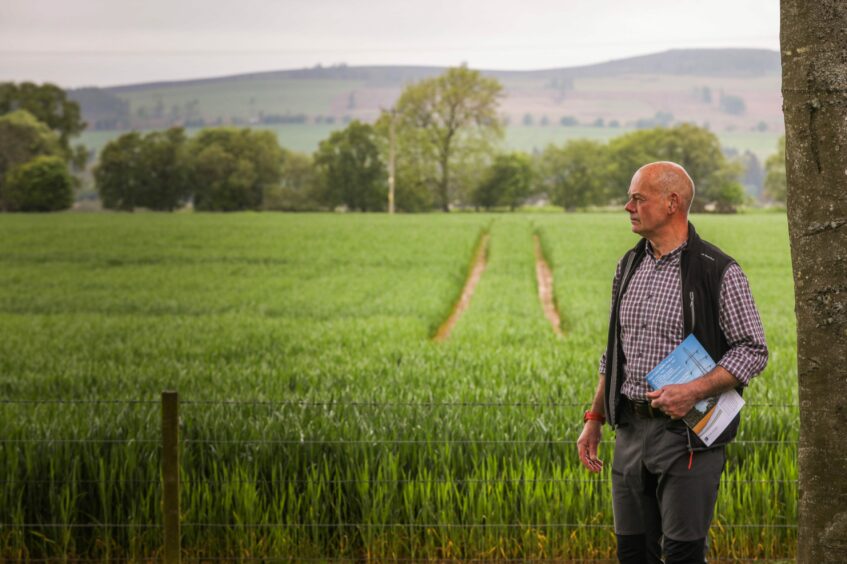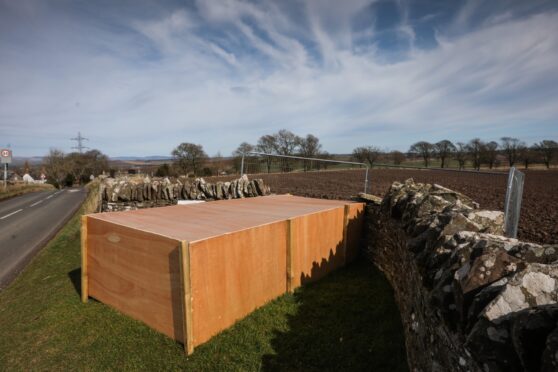Experts fear a line of ‘super-pylons’ running across Angus will threaten prime farmland in the area.
The planned 400kV pylon line will run from Fiddes, near Stonehaven, to a substation at Tealing.
But there is growing opposition from Angus and Mearns communities to the towers, averaging 55 metres in height.
Energy giant SSEN says the new infrastructure is essential since the existing 275kV pylon line is not suitable for upgrading.
They have also told communities the exact routing is still be be decided.
Pylons could hinder machinery movement
Leading figures at property consultancy firm Galbraith believe the size of the towers will impede large machinery typically employed in arable areas.
There are also concerns the high-voltage system could prevent watering high-value seed potato production.
The 66-mile route takes in Mearns landscapes immortalised by writer Lewis Grassic Gibbon in novels such as Sunset Song.
It will skirt the Iron Age caterthun hill forts in north Angus.
Tom Stewart, a partner at Galbraith said: “It is not clear why SSEN have taken this route rather than alternatives.
“There is normally a presumption against development on prime agricultural land.
“While this may be the cheapest route for SSEN to construct it threatens agricultural output in the area.
“A scheme of this nature introduces a significant threat to future cropping of potatoes and oilseed rape – key crops in this area.”
Potato disease worries
“Construction traffic introduces a significant biosecurity threat of spreading diseases such as eelworm and potato cyst nematode (PCN) the length of the route,” he added.
“PCN already costs Scottish agriculture over £25m a year.
“Not only will the tall towers have a significant impact in the flat landscape of the area, cropping fields with pylons is also much more difficult and will push up production costs.
“This does not seem to have been taken into account in route selection.”
Homeowners worried about property value
Some homeowners in affected areas are angry at the prospect of pylons affecting the value of their properties.
Many will receive no compensation.
Brechin man Ken Allison fears the line of pylons could pass within a few hundred metres of his rural home.
The former Royal Marine said he would give up work if he could afford to in order to fight the scheme.
Mike Reid, head of energy at Galbraith added: “Scotland’s drive for renewable energy sources has changed the pattern of power generation.
“It’s estimated that five times the infrastructure will be needed in the next seven years than was built in the past 30.
“These schemes need to take account of the wider, long-term impact on local landscapes, communities, businesses and property ownership.
“Given the scale and impact of the proposals particularly with regard to agricultural productivity, it is likely that a full environmental impact assessment will be required.”
Campaigners want to see power cables buried underground or laid offshore.
But Mr Reid said the underground option would be more expensive to install.
Consultation deadline extension
SSEN has extended the public consultation on the project until June 23.
Feedback can be submitted through a dedicated project website.
A spokesperson for SSEN Transmission said: “Once we progress to the development of potential route alignments, we will work with those impacted to microsite tower locations to minimise and mitigate potential impacts on farming operations.
“We recognise that there may be impacts on farming businesses and can confirm that appropriate levels of compensation will be agreed in line with established industry practices.
“As with all of our projects, a robust biosecurity management plan covering risk of agricultural pests and diseases will be implemented throughout the construction phase, along with extensive associated mitigation measures.
“It is important to reiterate that the project remains in the early stages of development and no specific overhead line route alignments have been identified.”
Construction is due to be completed in 2030.













Conversation